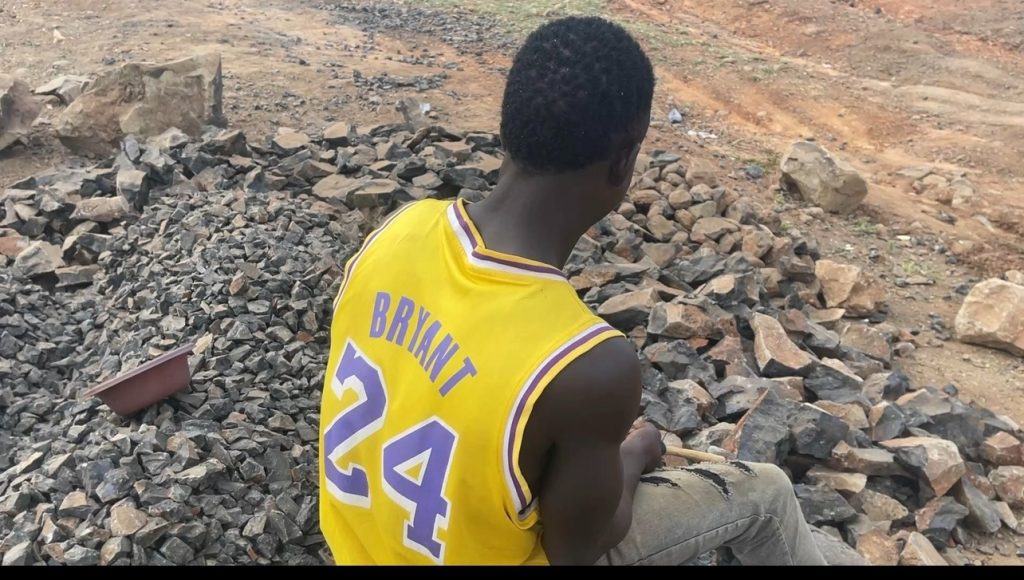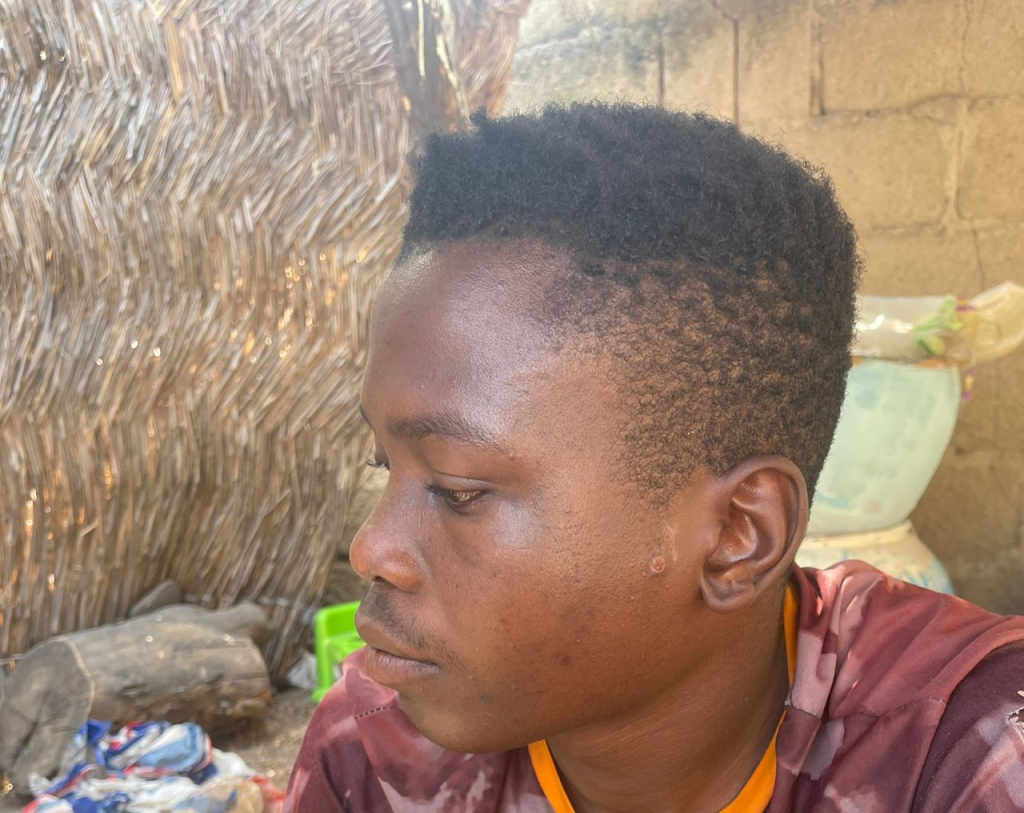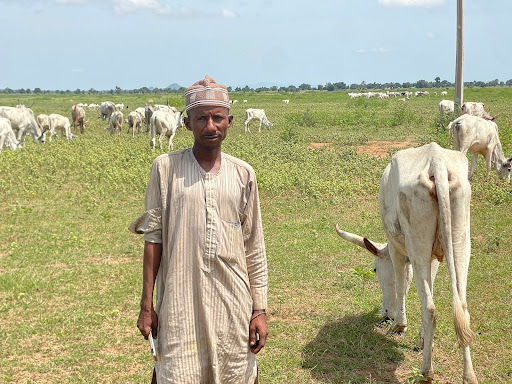In this Adamawa Community, Mountains Fall for Earnings to Rise
The easiest way to reach Savannah-Ngurore is to tell the cab drivers at the park that you’re headed to Wurin pasa dutse, a Hausa phrase meaning ‘the place stones are broken’. It is a rural community in Yola North Local Government Area, Adamawa State, northeastern Nigeria.
With no signposts leading into the community, the only marker is a bus stop across the road, directly opposite a once-massive mountain. For decades, its slopes have been cut down, felled, and flattened into stones and gravel by labourers who toil from dawn to dusk.
For many of these stone crushers, quarrying — the process of breaking rocks from the earth, either by hand or heavy machinery, for construction or industrial use — has been a means of survival for decades. Equipped with gloves, hammers, sunglasses, and sometimes heavy machinery, they leave home at dawn for the mountain they call ‘site’.
The only path he knew
Nehemiah Nuhu sits atop a pile of gravel he has broken. While his legs sprawl to the side, a hammer is clutched in his left hand, and his right hand is gloved. He continues to break the stones into tiny fragments. A small music box blasts Afrobeat rhythms beside him, its speaker carrying the beat across the dusty air.

“The mountain has slowly given way over the years,” he said. As one of the stone crushers who has been carving into the earth for nearly a decade, he has mastered the art of quarrying. His hands move very quickly as his hammer splits the stones in seconds.
The 28-year-old has been doing this since he reached adulthood. “I don’t have any job apart from this,” he told HumAngle. “It’s not a good job. It requires a lot of energy, and it’s very exhausting.” With high unemployment across the country, Nehemiah said his secondary school certificate is not enough to get him a white-collar job.
“Nobody taught me this business. This is something that has been going on in this community since I was a boy, so I grew up and joined them,” he said.
He explained that the struggle to survive drove him into quarrying. The trade provides him with an income to support himself and his younger siblings. Nehemiah believes the mountain is a gift from God to the community. He noted that most youths in Savannah-Ngurore have little or no formal education, and with few job opportunities, the quarry has become their only means of survival.
“Most of the youths from this community work here. We are happy that God gave us this mountain to break and earn a living from it.”

Daily labour, hard choices
Nehemiah and other stone crushers start their day by climbing the mountain to carve out excavations. From the top, they roll heavy rocks down a sloping channel that they have shaped over the years by repeated use. Once the stones reach the ground, they are gathered at the foot of the mountain, where they are broken into smaller pieces.
After the stones are reduced to gravel, they are measured in wheelbarrows and sold to individuals or dealers who come with trucks or open vans. Each wheelbarrow sells for about ₦400 or ₦500, and Nehemiah says he makes around ₦4,000 daily.
“I fill up like 10 wheelbarrows or more in a day. I come here every day and work from 6 a.m. to 12 p.m. Then I return home to rest. By 2 p.m., I come back and continue, then close around 5 p.m.,” he told HumAngle.
Sometimes, dealers call them to request specific quantities. “The ones that trust us give us contracts with specific targets, then we deliver to them,” Nehemiah said. When buyers don’t show up, they keep adding to their piles, waiting for the next order.

When other jobs fail
For 45-year-old Ibrahim Hassan, quarrying became a last resort after trying several jobs that yielded little or no results. He started working at the site about five months ago, and despite the physically demanding nature of the job, he finds satisfaction in it.
“Quarrying fetches quick cash,” he said. “I worked in a bread factory. I worked as a construction labourer, and I was a mechanic one time.”
He travels 40 minutes from Jimeta to Savannah-Ngurore every weekday. “I’m enjoying the work so far. Apart from its complex nature, I don’t have any problem with it.”

There is also 26-year-old Faruk Muhammed, who has been working at the site for a decade. From his earnings, he established a local tea shop around the community, which he runs alongside his quarrying business.
“I do both jobs hand in hand,” he said, face down as he split rocks. Faruk arrives at the site in the morning, leaves around noon to rest, and then prepares for his tea shop.
What he appreciates most about quarrying is not having to search for customers, since the dealers come to the site. “It’s a very tough job. You have to be strong to handle it, but I’m glad I use it to fend for myself. I don’t have to beg anyone for a penny,” he said.

A toll on the environment
Even though quarrying has become a source of livelihood for many in Savannah-Ngurore, the trade continues to burden the earth. Amid the heaps of broken rock lies a toll impossible to ignore.

Zaccheus Bent Adams, a geologist, said quarrying causes air pollution, biodiversity loss, flooding, and erosion, among other environmental and health hazards.
“Dust settles on leaves and can physically cover the surface, reducing the amount of sunlight available, which can lead to water stress because the pores on the leaves are crucial for gas exchange,” he stated. Such disruption, he added, affects water circulation above and below the earth’s surface.
He also said the extraction affects both aquatic and terrestrial ecosystems, destroying habitats and diminishing biodiversity. Zaccheus stressed that conserving biodiversity is essential because all species are interconnected and depend on one another for survival.
He added that climate change exacerbates these effects, contributing to droughts, heatwaves, rising sea levels and wildfires. “Extreme weather conditions increase storm and flood levels, causing damage to communities,” he said.
Living with risks
Quarrying comes with other risks and hazards to the stone crushers.
“While excavating the stones, we sometimes slip and fall, and when we manage to roll the rocks down the slope, we must stand firm or fall down the mountain,” Nehemiah said. He noted that several accidents had occurred at the site, resulting in injuries to workers. He himself bears scars from those incidents.
“The accidents are regular. Some died when the rocks crushed them during excavation. Others tripped and fell,” he told HumAngle.
Despite the dangers, the stone crushers show up every day. Although Faruk has not suffered any major accident, he has sustained injuries — and admits he is often afraid.
“If I get another job right now, I’ll quit quarrying. It’s strenuous. I don’t enjoy it. It’s just that the income helps me and my parents a lot,” he stated.
Zaccheus added that both residents and stone crushers are at risk of developing respiratory illnesses and symptoms such as shortness of breath. “Exposure to quarry dust has been linked to headaches, eye itches, and skin irritation,” he said.
Nearby communities, he noted, are not immune to the hazards. Landscape degradation, noise pollution, air pollution, and water contamination can lead to social tension and the loss of agricultural land.
Paying the price

Far from the clatter and the dust, 55-year-old Jauro Tafida, the community leader of Savannah-Ngurore, believes that these operations are responsible for several environmental challenges affecting the community. As someone who was born and raised in the area, Tafida draws a comparison to the rapidly vanishing landscapes.
“Before they started quarrying, our lands absorbed water, but now it flows through the lands and farmlands very easily,” he said, explaining that erosion is worsening.
During the rainy season, water cascades down the mountain along channels carved by the stone crushers, often causing floods that damage homes and farms.
“Where there were no holes before, you now see holes everywhere — even on our farmlands,” Tafida said.
He also noted that local water bodies are shrinking and vegetation is losing its richness.
“There are so many changes,” he told HumAngle. “Years ago, we didn’t bother about spraying herbicides or anything on our farms because the land is rich, but now, we must spray herbicides, and the harvest is no longer bountiful.”
Zaccheus confirmed that quarrying stirs up sand sediments, reduces water quality, and disrupts photosynthesis in plants, ultimately destabilising the food chain. “Coastal and riverine areas face increased erosion as sediment transport changes. Flooding also intensifies, with serious socio-economic impacts on farming communities,” he said.
The community leader said quarrying in Savannah-Ngurore began about fifteen years ago and has since intensified, attracting workers from neighbouring communities. “People from Rundamallu, Ngurore town, Jimeta, and other places all come here to work and then return home,” he said.
Some workers, he added, have died or suffered amputations after accidents. Yet he believes the practice will continue. “It will go on since the children have no other work. Quarrying keeps them occupied and prevents idleness,” he said.
Regulation gaps
The National Environmental Standards and Regulations Enforcement Agency (NESREA) Act, established in 2007, aims to prevent environmental degradation, air and noise pollution, and the obstruction of natural drainage channels. The Act restricts quarrying and blasting activities that cause public nuisance.
Similarly, Section 76 of the Nigerian Minerals and Mining Act prohibits individual quarrying. “Every operation for extracting any quarriable mineral, including sand dredging for industrial use, shall be conducted under a lease or licence granted by the Minister,” the Act states.
Before any lease for quarrying is granted, the legislation requires an environmental survey to determine approval. Despite these legal frameworks, quarrying activities continue largely unchecked. In 2024, it was reported that Nigeria loses about $9 billion annually to illegal mining and unlicensed quarry operators.
According to Zacchaeus, unregulated quarrying amplifies social and environmental harm. “The local miners aim to extract the stones without backfilling, which is required after every extraction,” he said. Backfilling, he explained, restores land and vegetation, creating new habitats for plants and animals. It ensures the area can be used again after mining is complete.
He urged the government to engage in community outreach to ensure the implementation of stricter environmental regulations or laws governing quarrying operations. “Through this, the negative impact on the environment and local communities would be minimised,” he said.
Zaccheus also called on policymakers to conduct regular environmental impact assessments to evaluate the effects of quarrying on ecosystems and water quality. “Sustainable practice is the key,” he stressed, “because it promotes rehabilitation and the protection of biodiversity.”














